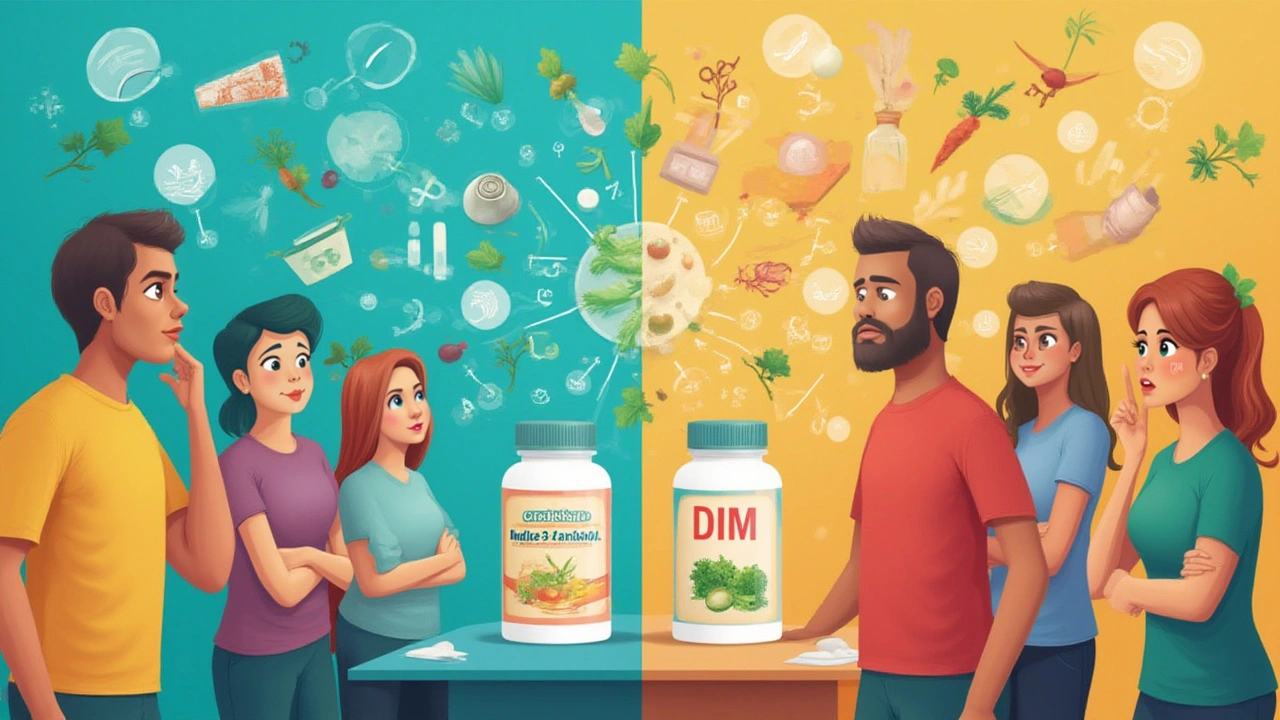You probably don’t realize how much cabbage, broccoli, and kale could change your mood—or even your period. People used to roll their eyes at anyone slapping a "superfood" label on vegetables, but science is inching shockingly closer to proving some of those claims true. The twist lies in two hard-to-pronounce chemical cousins found in our favourite greens: indole-3-carbinol (I3C) and diindolylmethane (DIM). They’re not just buzzwords. They’re both being eyed by doctors, nutritionists, and wellness nerds for very real hormone and detox benefits.
But here’s what trips everyone up: Do you choose I3C or DIM? Is one better for supporting clear skin, balanced moods, or a healthy liver? Or does it just depend on what kind of stubborn symptoms you’re wrestling with? Before you pop another pill or make a smoothie disaster in your kitchen, it’s worth seeing which of these two superheroes actually delivers more for your health goals.
What Are Indole-3-Carbinol and DIM?
On the surface, indole-3-carbinol and DIM sound like they’ve tumbled out of a chemistry set, not your salad bowl. But every time you crunch on cruciferous veg—think broccoli, Brussels sprouts, cauliflower, cabbage—you actually unleash I3C. It forms naturally when those veggies are chopped, chewed, or digested. Your body then turns I3C into DIM. So yes, both these molecules are really different stages of the same process. Think of I3C as the raw ingredient, DIM as the product after your body has tinkered with it.
The magic—if you’d call it that—starts in your stomach’s acidic environment. I3C is a bit of a chameleon; as soon as it hits stomach acid, it’s converted into DIM and a cocktail of even more mysterious compounds. Crucially, DIM is the star that usually gets all the attention in scientific studies, especially for hormone support and detox.
I3C has a bit more research history behind it because it was discovered first and tested as a supplement long before DIM caught the wellness world’s eye. Initial excitement centered on I3C’s ability to help balance oestrogen metabolism and possibly support cellular health at a level most vitamins simply don’t touch. More recent studies highlight DIM for its role in supporting healthy hormone ratios, helping the body ditch excess or “bad” estrogens, and even modulating immune function gently rather than with a sledgehammer.
If you want to geek out on the nitty-gritty, people usually get I3C straight from food, while DIM supplements are made by concentrating that converted compound. That means I3C has a fleeting existence in your body—it’s tricky to measure and even harder to predict—whereas DIM offers a more direct, stable compound to work with.
How Do Indole-3-Carbinol and DIM Work for Detox?
The word "detox" gets tossed around like a trendy hashtag, but both indole-3-carbinol and DIM offer something a bit more biologically grounded than your average juice cleanse. Detox, scientifically speaking, means giving the liver a hand in breaking down hormones and potential toxins so your body can get rid of them. Both I3C and DIM support Phase I and Phase II liver enzymes—the teams that actually process and eliminate unwanted chemicals.
What stands out for I3C is its broader approach. Because it acts as a precursor, it ends up generating a wider mix of compounds in your body. Some of these oxidative metabolites may help sweep out heavy hitters like environmental chemicals, xenoestrogens (those fake oestrogen imposters from plastics), and metabolic wastes. For instance, researchers have suggested that I3C intake can actually help ramp up detox enzymes called cytochromes, making the liver more efficient at its job.
DIM, though, is often seen as more targeted. In terms of science, DIM nudges your liver toward making "good" oestrogen metabolites—like 2-hydroxyestrone—instead of the more problematic "bad" ones, such as 16-alpha-hydroxyestrone. This little balance tweak is linked to easier monthly cycles and fewer hormonal symptoms for many women. Plus, there’s honest-to-goodness evidence suggesting DIM may support the body’s natural defenses against oxidative stress, which adds another layer to the detox story.
The key tip here? If you’re dealing with a heavy toxic burden, such as lots of synthetic chemicals from beauty products, or if you’re coming off hormonal contraceptives, I3C can be handy since it generates multiple compounds. For those with persistent hormonal symptoms—bloating, breast tenderness, skin flare-ups—DIM might be sharper at getting the ratio of oestrogen metabolites under control.
It’s not just theory either. In a well-cited study from the journal Cancer Epidemiology, Biomarkers & Prevention, subjects taking DIM supplements saw meaningful shifts in their oestrogen profiles after a few weeks. That conversion is real, not wishful thinking.

Hormone Balance: Who Wins?
Ask anyone struggling with PMS, acne, or mood swings, and the answer you’ll get is: balance isn’t just about oestrogen levels, but getting the right types of oestrogen floating through your system. Both I3C and DIM pull their weight here, but they go about it differently.
I3C works at the start of the pathway, helping transform “dirty” or problematic forms of oestrogen into less potent, more easily eliminated ones. In clinical trials involving women with cyclical hormone symptoms, I3C supplementation led to noticeably fewer breast discomfort days and milder PMS experiences. It’s also being explored for its effects on other hormone-driven issues, like fibroids and endometriosis, though that research isn’t as solid yet.
DIM, by contrast, is focused squarely on the critical ratio of 2-hydroxy and 16-hydroxy oestrogen metabolites. This matters because a higher 2-to-16 ratio is linked to lower risk of hormone-driven cancers and fewer “hormonal storms.” One interesting side note—for women on hormone replacement therapy or recovering from high-oestrogen conditions, DIM often brings faster results in balancing that ratio. A European study even found that DIM lowered certain inflammatory markers related to oestrogen dominance within three months.
Here’s the tip you never hear: DIM is gentler on the stomach than I3C, which can cause mild digestive upsets in sensitive people. If you’ve got a finicky tummy—or you want the reliability of a more easily absorbed supplement—DIM may edge ahead.
One more twist: Men aren’t left out. Both supplements are used by men wanting to support better testosterone to oestrogen ratios, which is especially relevant for anyone dealing with excess belly fat, low energy, or performance slumps. I3C’s broader activity may help with environmental toxin overload, while DIM’s focused action is favoured in men’s bodybuilding circles for keeping oestrogen in check.
If you want to give I3C a try, you can start with a quality indole-3-carbinol supplement and see how your body responds, especially if your detox systems need a complete reset before moving to DIM.
Choosing Between I3C and DIM: Practical Tips
If you’re still stuck on which to use, here’s a simple guide. Start with your main health goal. If hormone balance—think PMS, heavy cycles, breast swelling, or adult acne—is the top priority, most nutritionists suggest starting with DIM, since it delivers a direct, predictable effect on oestrogen metabolites with less digestive drama. It’s easier to measure success and safest for most people, especially if you’re on other medications.
But if your bigger challenge is exposure to synthetic chemicals, or if you’ve spent years on HRT or birth control and feel your liver needs a full reset, I3C can make a broader difference. It introduces more active metabolites and helps sweep out a wider range of environmental oestrogens and stubborn hormone residues. Go slow—start with a low dose, increase gradually, and pay attention to how your body (especially your gut) reacts.
Always look for quality brands that use pure formulas with minimal fillers. Check labels for allergen info and opt for third-party tested products if you can. Combining either supplement with a cruciferous-rich diet—like roasted Brussels with garlic or an easy broccoli salad—amplifies the effect, thanks to real food bringing along extra phytochemicals, fibre, and antioxidants.
Some people try stacking both I3C and DIM, especially during the first few months of a hormone or detox protocol, but this isn’t necessary for everyone. Consulting a nutritionist or GP who knows about these supplements is always smart. They can help tailor your approach, especially if you take prescription meds or have underlying health conditions.
Don’t forget: Both compounds need a healthy digestive system for best results. Boost your stomach acid (think apple cider vinegar shots or bitters) if absorption is a concern, and add fibre-rich foods to support elimination. Stay hydrated—detox works best when your body isn’t fighting dehydration.
You really don’t have to guess or hope for the best. These two cousins aren’t just wellness fads—they’re backed by a quietly growing pile of research showing real benefits for hormone health and detox. It just comes down to picking the right tool for your situation and listening to your body—not what a social media ad tells you.


Comments (5)
Marshall Pope
July 18, 2025 AT 14:59i legit thought dim was just some fancy gym supplement til i read this. now i get why my skin cleared up after i started taking it. no more cystic acne, no more mood swings. weird how broccoli is basically a hormone wizard 🤯
Nonie Rebollido
July 18, 2025 AT 15:24i tried i3c first and my stomach hated it. like, actual burning. switched to dim and boom-no issues, same results. also, my period is way more chill now. i’m not a scientist but i know what works on me 😌
Agha Nugraha
July 19, 2025 AT 14:31interesting. i’ve been eating a ton of kale and broccoli lately but never thought about the chemistry behind it. maybe i should try a supplement. i’ve had weird mood swings since quitting birth control last year.
Andy Smith
July 20, 2025 AT 19:45The distinction between I3C and DIM is clinically significant, and this post accurately captures the biochemical nuance: I3C is a pH-dependent precursor that undergoes non-enzymatic condensation in gastric acid to yield DIM and other indole derivatives; DIM, by contrast, is a stable, bioavailable compound with direct aryl hydrocarbon receptor (AhR) modulation. Most clinical trials (e.g., Cancer Epidemiology, Biomarkers & Prevention, 2010) demonstrate DIM’s superiority in shifting estrogen metabolism toward the 2-hydroxy pathway, reducing 16-alpha-hydroxyestrone-a known genotoxic metabolite. Furthermore, DIM’s lower gastrointestinal irritancy profile makes it preferable for long-term use. However, I3C may offer broader detoxification support in cases of heavy xenoestrogen exposure, due to its multi-metabolite profile. Always consult a provider before combining with hormonal therapies.
Rekha Tiwari
July 20, 2025 AT 23:28OMG YES. I started taking DIM after my endo diagnosis and my pain dropped by like 70%. Also, my skin stopped looking like a war zone 🌸. I eat broccoli every day now and take a 100mg DIM capsule-no drama, no crashes. If you’re struggling with hormones, don’t ignore this stuff. It’s not magic, it’s science. And yes, it’s okay to be weird about your veggies 😘